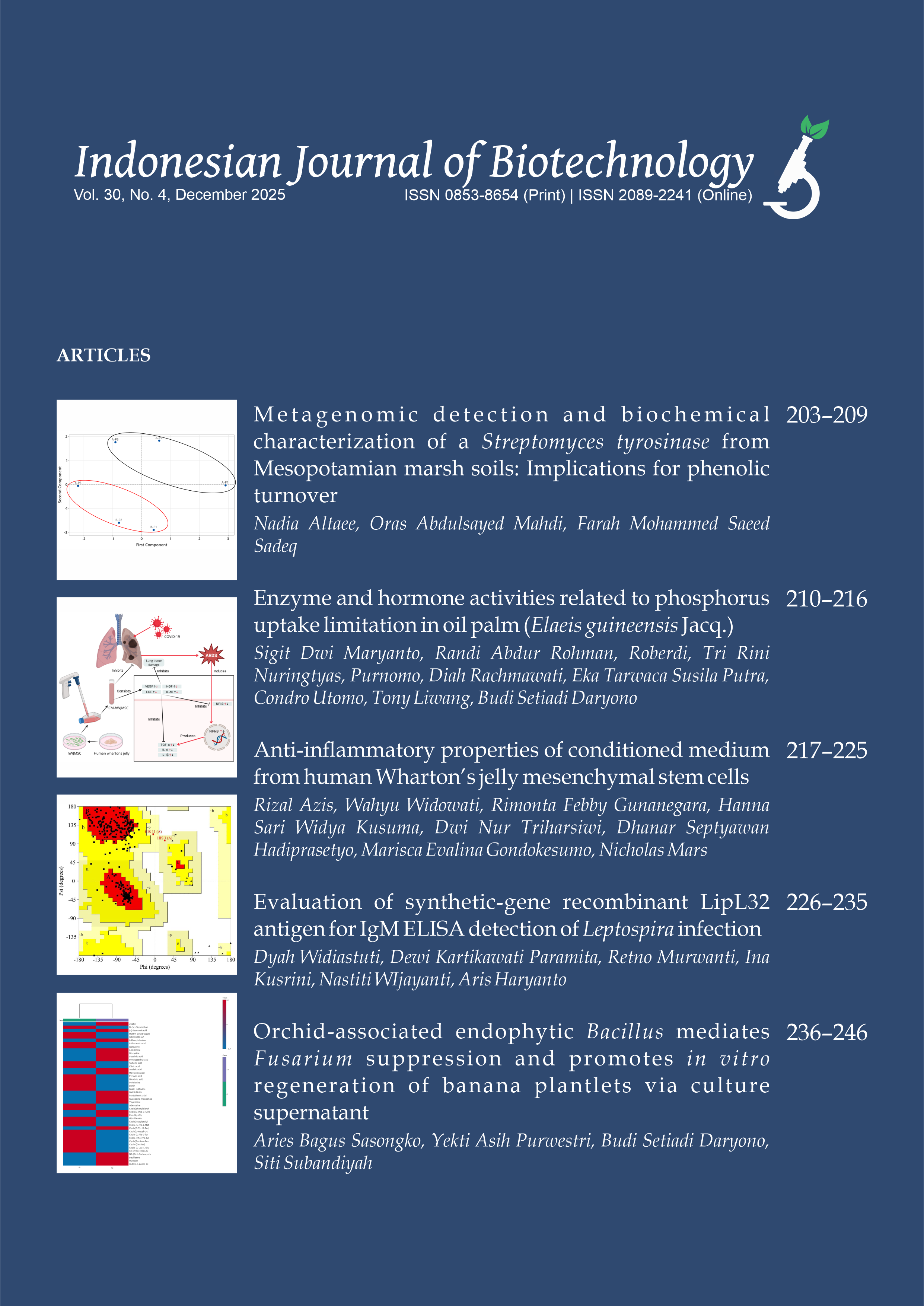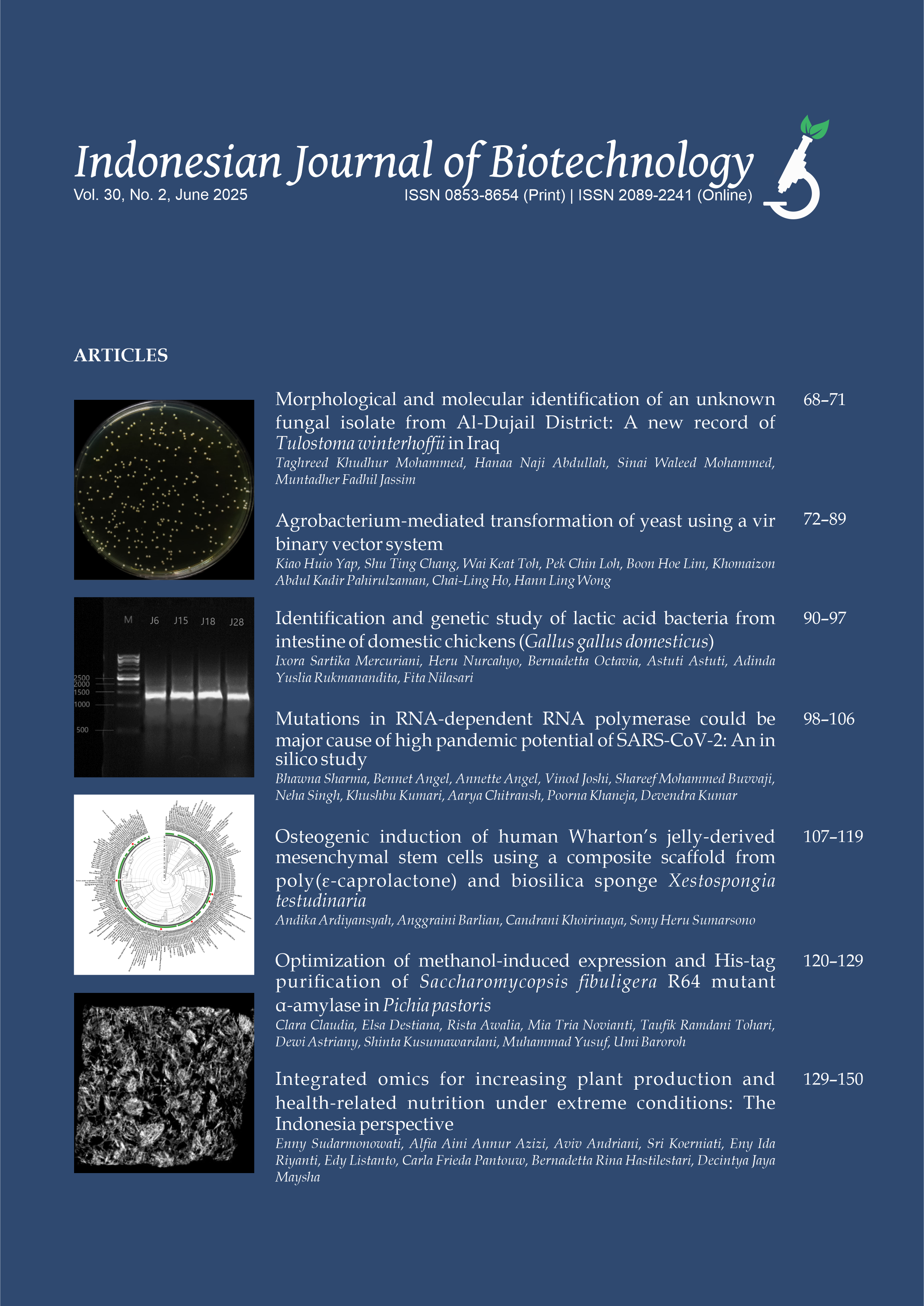Atrazine degradation by Bacillus safensis strain BUK_BCH_BTE6 isolated from agricultural land in northwestern Nigeria
Faisal Muhammad(1), Hafeez Muhammad Yakasai(2*), Mohd Yunus Shukor(3)
(1) Department of Biochemistry, Faculty of Basic Medical Sciences, College of Health Sciences, Bayero University Kano, P.M.B. 3011, Kano State, Nigeria
(2) Department of Biochemistry, Faculty of Basic Medical Sciences, College of Health Sciences, Bayero University Kano, P.M.B. 3011, Kano State, Nigeria
(3) Department of Biochemistry, Faculty of Biotechnology and Biomolecular Sciences, Universiti Putra Malaysia, 43400 Serdang, Selangor Darul Ehsan, Malaysia
(*) Corresponding Author
Abstract
Keywords
Full Text:
PDFReferences
Abigail EA, Abdul Salam J, Das N. 2013. Atrazine degradation in liquid culture and soil by a novel yeast Pichia kudriavzevii strain Atz-EN-01 and its potential application for bioremediation. J. Appl. Pharm. Sci. 3(6):35–43. doi:10.7324/JAPS.2013.3606.
Ahmad FA, Yusuf F, Shehu U, Muhammad F, Yakasai HM. 2022. Isolation and identification of chromiumreducing bacteria from Challawa Industrial Area Kano State, Nigeria. J. Adv. Microbiol. 22(1):15–23. doi:10.9734/jamb/2022/v22i130426.
Ali N, Dashti N, Khanafer M, Al-Awadhi H, Radwan S. 2020. Bioremediation of soils saturated with spilled crude oil. Sci. Rep. 10(1):1116. doi:10.1038/s41598- 019-57224-x.
Alvarez A, Saez JM, Davila Costa JS, Colin VL, Fuentes MS, Cuozzo SA, Benimeli CS, Polti MA, Amoroso MJ. 2017. Actinobacteria: Current research and perspectives for bioremediation of pesticides and heavy metals. Chemosphere 166:41–62. doi:10.1016/j.chemosphere.2016.09.070.
Andleeb S, Jiang Z, ur Rehman K, Olajide EK, Ying Z. 2016. Influence of soil pH and temperature on atrazine bioremediation. J. Northeast Agric. Univ. (English Ed.) 23(2):12–19. doi:10.1016/s1006- 8104(16)30043-5.
Ariole C, Abubakar A. 2015. Biodegradation of atrazine by bacteria isolated from lotic water. J. Appl. Life Sci. Int. 2(3):119–125. doi:10.9734/jalsi/2015/14345.
Benjamin SR, Lima FD, Florean EOPT, Guedes MIF. 2019. Current trends in nanotechnology for bioremediation. Int. J. Environ. Pollut. 66(1-3):19–40. doi:10.1504/IJEP.2019.104526.
Brahmbhatt D. 2012. Molecular identification of bacteria using 16s rDNA sequencing. [Unpublished]. Master’s thesis, Gujarat University, India. Charpe A, Sedani S, Murumkar R, Bhad R. 2019. Effect of temperature on microbial growth in food during storage. JMultilogic Sci. VIII(Special Issue):56–68.
Chikere C, Ugueri U. 2014. Effect of growth media and incubation time on the culturability of soil bacteria. IOSR J. Pharm. Biol. Sci. 9(2):06–09. doi:10.9790/3008-09210609.
Cho SJ, Kim MH, Lee YO. 2016. Effect of pH on soil bacterial diversity. J. Ecol. Environ. 40:10. doi:10.1186/s41610-016-0004-1.
Debasmita N, Rajasimman M. 2013. Optimization and kinetics studies on biodegradation of atrazine using mixed microorganisms. Alexandria Eng. J. 52(3):499–505. doi:10.1016/j.aej.2013.06.008.
Dehghani M, Nasseri S, Hashemi H. 2013. Study of the bioremediation of atrazine under variable carbon and nitrogen sources by mixed bacterial consortium isolated from corn field soil in Fars Province of Iran. J. Environ. Public Health 2013:973165. doi:10.1155/2013/973165.
Fernandes AFT, Wang P, Staley C, Moretto JAS, Altarugio LM, Campanharo SC, Stehling EG, Sadowsky MJ. 2020. Impact of atrazine exposure on the microbial community structure in a Brazilian tropical latosol soil. Microbes Environ. 35(2):ME19143. doi:10.1264/jsme2.ME19143.
He H, Liu Y, You S, Liu J, Xiao H, Tu Z. 2019. A review on recent treatment technology for herbicide atrazine in contaminated environment. Int. J. Environ. Res. Public Health 16(24):5129. doi:10.3390/ijerph16245129.
Khatoon H, Rai JP. 2020. Optimization studies on biodegradation of atrazine by Bacillus badius ABP6 strain using response surface methodology. Biotechnol. Rep. 26:e00459. doi:10.1016/j.btre.2020.e00459.
Kolekar PD, Phugare SS, Jadhav JP. 2014. Biodegradation of atrazine by Rhodococcus sp. BCH2 to Nisopropylammelide with subsequent assessment of toxicity of biodegraded metabolites. Environ. Sci. Pollut. Res. 21(3):1334–1343. doi:10.1007/s11356- 013-2151-6.
Li MR, Zhan FD, Chen JJ, Zu YQ, Li Y. 2020. Atrazine degradation pathway and genes of Arthrobacter sp. Fm326. Polish J. Environ. Stud. 29(5):3683–3689. doi:10.15244/pjoes/115326.
Li Y, Liang D, Sha J, Zhang J, Gao J, Li H, Liu R. 2019. Isolating and identifying the atrazinedegrading strain Arthrobacter sp. LY-1 and applying it for the bioremediation of atrazine-contaminated soil. Polish J. Environ. Stud. 28(3):1267–1275. doi:10.15244/pjoes/86219.
Macwilliams MP, Liao MK. 2016. Luria Broth (LB) and Luria Agar (LA) media and their uses protocol. Am. Soc. Microbiol. October 2006:18– 21. URL https://asm.org/Protocols/Luria-Broth-LB-a nd-Luria-Agar-LA-Media-and-Their-U.
Mansee, Ayman and Bakry, Nabila and Doaa EG. 2017. Factors affecting potentials of certain bacterial isolates for atrazine bioremediation. Agric. Eng. Int. CIGR J. Special Issue:91–100.
Meenambigai P, Vijayaraghavan R, Gowri RS, Rajarajeswari P, Prabhavathi P. 2016. Biodegradation of heavy metals – A review. Int. J. Curr. Microbiol. Appl. Sci. 5(4):375–383. doi:10.20546/ijcmas.2016.504.045.
Muhammad F, Yusuf F, Ahmad F, Shehu U, Yakasai H. 2021. Optimizing the effect of pH and temprature on atrazine degradation by Bacillus safensis strain BUK_BCH_BTE6 an efficient atrazine tolerating bacteria from an agricultural soil in Kura Local Government Area of Kano State, Nigeria. Niger. J. Biotechnol. 38(2):92–100. doi:10.4314/njb.v38i2.10.
Olu-Arotiowa O, Ajani A, Aremu M, Agarry S. 2019. Bioremediation of atrazine herbicide contaminated soil using different bioremediation strategies. J. Appl. Sci. Environ. Manag. 23(1):99–109. doi:10.4314/jasem.v23i1.16.
Omotayo AE, Ilori MO, Obayori OS, Amund OO. 2016. Influence of pH, temperature and nutrient addition on the degradation of atrazine by Nocardioides spp. isolated from agricultural soil in Nigeria. Malays. J. Microbiol. 12(4):270–278. doi:10.21161/mjm.81315.
Owagboriaye F, Oladunjoye R, Aina S, Adekunle O, Salisu T, Adenekan A, Abesin O, Oguntubo J, Fafioye O, Dedeke G, Lawal O. 2022. Outcome of the first survey of atrazine in drinking water from Ijebu-North, South-West, Nigeria: Human health risk and neurotoxicological implications. Toxicol. Rep. 9:1347– 1356. doi:10.1016/j.toxrep.2022.06.012.
Sawangjit S. 2016. Isolation and characterization of atrazine-degrading Xanthomonas sp. ARB2 and its use in bioremediation of contaminated soils. Int. J. Environ. Sci. Dev. 7(5):351–354. doi:10.7763/IJESD.2016.V7.798.
Shamsedini N, Baghapour MA, Dehghani M, Nasseri S. 2015. Photodegradation of atrazine by ultraviolet radiation in different conditions. J. Health Sci. Surveill. Syst. 3(3):94–100.
Shehu U, Ahmad FA, Yusuf F, Muhammad F, Yakasai HM. 2021. Isolation and identification of anthracene utilizing Proteus vulgaris from oil spill contaminated soil at NNPC Depot Kano State Nigeria. J. Adv. Biol. Biotechnol. 24(10):46–53. doi:10.9734/jabb/2021/v24i1030246.
Shiri MA, Dehghani M, Samaei MR. 2016. Isolation of atrazine degrading bacteria in semi-salinity medium. J. Health Sci. Surveill. Syst. 4(3):121–128. Singh B, Singh K. 2016. Microbial degradation of herbicides. Crit. Rev. Microbiol. 42(2):245–261. doi:10.3109/1040841X.2014.929564.
Swissa N, Nitzan Y, Langzam Y, Cahan R. 2014. Atrazine biodegradation by a monoculture of Raoultella planticola isolated from a herbicides wastewater treatment facility. Int. Biodeterior. Biodegrad. 92:6–11. doi:10.1016/j.ibiod.2014.04.003.
Umar AB, Dankaka AH, Sambo FI. 2020. Comparative ecological variation and its effect on abundance of mosquito population in Kura and Dala Local Government, Kano State Nigeria. Kano, Nigeria: Yusuf Maitama Sule University.
Wang J, Zhu L, Wang Q, Wang J, Xie H. 2014. Isolation and characterization of atrazine mineralizing Bacillus subtilis strain HB-6. PLoS One 9(9):e107270. doi:10.1371/journal.pone.0107270.
Warsi M, Bee N, Hashim M, Ahmad M, Kumar U, Khan S. 2017. Isolation and molecular identification of pesticides tolerant bacteria in agriculture soil of Rampur (U.P). Int. J. Biotechnol. Res. (IJBTR) 7:25–40.
Ye JY, Zhang JB, Gao JG, Li HT, Liang D, Liu RM. 2016. Isolation and characterization of atrazinedegrading strain Shewanella sp. YJY4 from cornfield soil. Lett. Appl. Microbiol. 63(1):45–52. doi:10.1111/lam.12584.
Zhang J, Liang S, Wang X, Lu Z, Sun P, Zhang H, Sun F. 2019. Biodegradation of atrazine by the novel Klebsiella variicola strain FH-1. Biomed Res. Int. 2019:4756579. doi:10.1155/2019/4756579.
Zhang Y, Ning Z, Zhao J, Xinran P, Shuyan M, Miao H. 2009. Isolation of two atrazine-degrading strains and their degradation characteristics. Int. J. Agric. Biol. Eng. 2(3):27–32. doi:10.3965/j.issn.1934- 6344.2009.03.027-032.
Zhao X, Wang L, Du L, Yang J, Dong J, Ma F. 2017. Optimization of culturing conditions for isolated: Arthrobacter sp. ZXY-2, an effective atrazinedegrading and salt-adaptive bacterium. RSC Adv. 7(53):33177–33184. doi:10.1039/c7ra04661h.
Zhao X, Wang L, Ma F, Yang J. 2018. Characterisation of an efficient atrazine-degrading bacterium, Arthrobacter sp. ZXY-2: An attempt to lay the foundation for potential bioaugmentation applications. Biotechnol. Biofuels 11:113. doi:10.1186/s13068-018-1113-0.
Zhu J, Fu L, Jin C, Meng Z, Yang N. 2019. Study on the isolation of two atrazine-degrading bacteria and the development of a microbial agent. Microorganisms 7(3):80. doi:10.3390/microorganisms7030080.
Article Metrics
Refbacks
- There are currently no refbacks.
Copyright (c) 2023 The Author(s)

This work is licensed under a Creative Commons Attribution-ShareAlike 4.0 International License.









